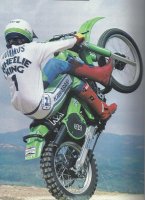Gary_Semics
PR Member
(The Art of the Wheelie)

 There’s no doubt about it wheelies are cool; they’ve always been cool. Not only are they cool but they also have benefits in motocross racing which we’ll see later in these riding tips. Just about anyone can master the wheelie if they understand the correct techniques and get a lot of consistence and frequent practice in. Of course the key to mastering the wheelie is balance. There is front to back balance and side to side balance. The front to back balance is controlled with body movement and the throttle and rear brake, even the clutch at first in order to get it up, the front wheel that is. Once you have it up (in the balance point range, more on this later) it’s a matter of keeping it there and keeping it straight.
There’s no doubt about it wheelies are cool; they’ve always been cool. Not only are they cool but they also have benefits in motocross racing which we’ll see later in these riding tips. Just about anyone can master the wheelie if they understand the correct techniques and get a lot of consistence and frequent practice in. Of course the key to mastering the wheelie is balance. There is front to back balance and side to side balance. The front to back balance is controlled with body movement and the throttle and rear brake, even the clutch at first in order to get it up, the front wheel that is. Once you have it up (in the balance point range, more on this later) it’s a matter of keeping it there and keeping it straight.
Techniques for keeping it in the balance range (the balance point).
What exactly is the balance range and point? The balance range is the range relating to the angle of the height of the front wheel. If the angle goes too high (the front wheel gets too high) the M/C will go over backwards. This is why you have to be able to control the rear brake. If the angle of the M/C is too low it will fall back down and out of the balance range. The latter is where you would have to lean back and give it more throttle. The balance point is where you and the M/C are at the perfect angle in the balance range. This is where the M/C doesn’t try to go back anymore or forward anymore. You don’t have to slow down with the rear brake in order to lower the front or you don’t have to pick up speed in order to raise the front. You are in the wheelie’s perfect balance point. Of course this is much easier to accomplish on smooth ground (such as pavement) but when the ground in uneven it takes an uncanny amount of balance and control with your body movements, throttle and rear brake.
Part 2 coming soon. In the mean time start out practicing on a slight uphill and get used to keeping your foot on the rear brake. Don't use it unless you start to go over backwards but keep your foot on it just in case.
For more free riding tips, free MX Technique DVD teasers, order online and MX Schools visit; www.garysemics.com

Techniques for keeping it in the balance range (the balance point).
What exactly is the balance range and point? The balance range is the range relating to the angle of the height of the front wheel. If the angle goes too high (the front wheel gets too high) the M/C will go over backwards. This is why you have to be able to control the rear brake. If the angle of the M/C is too low it will fall back down and out of the balance range. The latter is where you would have to lean back and give it more throttle. The balance point is where you and the M/C are at the perfect angle in the balance range. This is where the M/C doesn’t try to go back anymore or forward anymore. You don’t have to slow down with the rear brake in order to lower the front or you don’t have to pick up speed in order to raise the front. You are in the wheelie’s perfect balance point. Of course this is much easier to accomplish on smooth ground (such as pavement) but when the ground in uneven it takes an uncanny amount of balance and control with your body movements, throttle and rear brake.
Part 2 coming soon. In the mean time start out practicing on a slight uphill and get used to keeping your foot on the rear brake. Don't use it unless you start to go over backwards but keep your foot on it just in case.
For more free riding tips, free MX Technique DVD teasers, order online and MX Schools visit; www.garysemics.com
